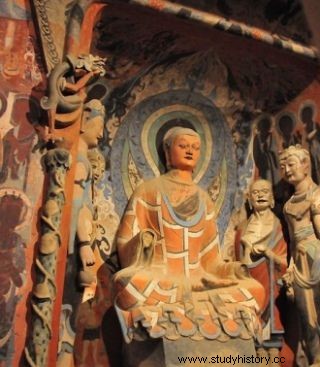Party in arms, Party advises, Party will never betray you! And at the head of this Party is proudly beloved Chairman Mao, father of the nation and friend of every Chinese. How to celebrate it in a place full of priceless ancient art? On a grand scale!
On the Mingsha Shan plateau there is a one-of-a-kind complex of rock grottos, known as the Mogao Caves. From about the fourth century AD, 492 caves were dug there, which artists of that time gradually covered with unique paintings. In addition, in caves, archaeologists found, among others, statues and manuscripts. Let us add that the mentioned caves served as temples for the locals. And that's it for the introduction. But what the hell does the Party and Chairman Mao have to do with it? Well, quite a lot.
1966 was the 1600th anniversary of the first caves, according to the date read on one of the Tang Dynasty stellas. The research institute working in the complex wanted to celebrate this event in the most spectacular way, after all, to celebrate the "birthday" of one of the elements of the world's cultural heritage. Party leaders, leading scholars and representatives of great religions, whose influences intertwined in the art of Mogao, announced their arrival. For the celebrations to be worthy, it was decided to give the caves a new… socialist dimension.
On the occasion of the millennium, the supporters of the only right Party decided to adapt one of the caves, which was not covered with paintings. The revolutionary artists were to commemorate the great - or rather, the period of dubious splendor - of the era of socialism. How was this supposed to work in practice?

"In the place where the Buddha statue was traditionally erected, a newly forged statue of Chairman Mao was to be erected" ... But we prefer the more traditional version!
Socialist dream of Buddhist art?
Individual caves were rectangular in shape or based on a square plan, topped with a richly decorated vault. In the central place there was a statue of Buddha, surrounded by smaller sculptures. The walls were first covered with clay and a kind of cement, and then with various religious paintings. How, then, to transform a typical temple layout for the needs of the Party? In the place of the Buddha, erect a freshly carved statue of Chairman Mao Zedong, and cover the walls with images of working people. The exact plan for this project is described by Gao Ertai, author of the book "In Search of the Fatherland":
In the place where the Buddha statue was traditionally erected, a newly forged statue of Chairman Mao was to be erected, and on the west wall, behind the statue, the history of the Chinese Communist Party entitled »Our victorious march among dangerous bluffs and rushing streams«. On the southern wall, the intention was to present the history of wars with Japan and the wars of liberation under the title "Long live the victorious wars of the people". The north wall was to showcase the achievements of the new China - "the 600 million that inhabit a divine land is as large as the ancient sages." On the ceiling, there should have been a marvelous perspective of a communist paradise under the title "A land blooming with hibiscus and bathed in the morning sun."

The article is based on the book "In search of the homeland" by Gao Ertai, Czarne Publishing House, Wołowiec 2012.
The resolution was adopted and the preparation of projects began with the slogan of planting a "red flower among dense foliage". As Gao wrote (ironically perhaps?), This work was to be a glorious political assignment , a Studying the history of the Party and deepening our understanding of its ideology through creative work is a great opportunity to reform our thinking.
Everything would be perfect if it wasn't for one minor problem. At the top of power, the tiller of politics turned a little sideways, and all ideology followed suit, including that of art. In a word, the great project in Mogao has become obsolete. At political parties he was quickly referred to as waving a red banner against a red banner in the hands of the people which equated to subversion.
The undertaking was abandoned, and its originators and executors faced political repression. Overnight, from the leaders of socialist art, they transformed into the so-called "right-wing element", beaten and humiliated by the active and correct (at that time) party ideology. And it was supposed to be so beautiful…
Sources:
Gao Ertai, In search of a homeland. Memories from a Chinese labor camp , crowd. Julita Grodek, Czarne, 2012.
